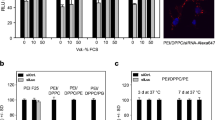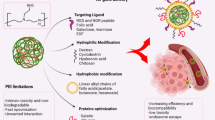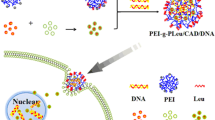Abstract
Purpose
We tested polyplexes of a diblock polymer containing a pH-responsive, endosomolytic core (dimethylaminoethyl methacrylate and butyl methacrylate; DB) and a zwitterionic Poly (methacryloyloxyethyl phosphorylcholine) (PMPC) corona for the delivery of plasmid DNA (pDNA) to glioblastoma cells.
Methods
We studied the physicochemical characteristics of the DNA polyplexes such as particle hydrodynamic diameter and surface potential. Cytocompatibility of free PMPC-DB polymer and pDNA polyplexes with U-87MG and U-138MG glioma cell lines were evaluated using the ATP assay. The transfection activity of luciferase pDNA polyplexes was measured using a standard luciferase assay. Anti-proliferative, apoptotic, and cell migration inhibitory activities of PMPC-DB/Interferon-beta (IFN-β1) pDNA polyplexes were examined using ATP assay, flow cytometry, and wound closure assay, respectively.
Results
PMPC-DB copolymer condensed pDNA into nanosized polyplexes. DNA polyplexes showed particle diameters ranging from ca. 100–150 nm with narrow polydispersity indices and near electroneutral zeta potential values. PMPC-DB/Luciferase pDNA polyplexes were safe and showed an 18-fold increase in luciferase expression compared to the gold standard PEI polyplexes in U-87MG cells. PMPC-DB/IFN-β1 polyplexes induced apoptosis, demonstrated anti-proliferative effects, and retarded cell migration in glioblastoma cells.
Conclusion
The results described herein should guide the future optimization of PMPC-DB/DNA delivery systems for in vivo studies.











Similar content being viewed by others
Abbreviations
- DLS:
-
Dynamic light scattering
- DMAEMA-BMA:
-
Dimethylaminoethyl methacrylate and butyl methacrylate
- GFP:
-
Green fluorescence protein
- IFN-β1:
-
Interferon beta-1
- Luc:
-
Luciferase
- PC:
-
Phosphatidylcholine
- pDNA:
-
Plasmid deoxyribonucleic acid
- PEG:
-
Polyethylene glycol
- PMPC:
-
Poly (methacryloyloxyethyl phosphorylcholine)
- PMPC-DB:
-
Poly (methacryloyloxyethyl phosphorylcholine) conjugated with DMAEMA-BMA
- siRNA:
-
Small interfering ribonucleic acid
- U-138MG:
-
Uppsala 138 malignant glioma
- U-87MG:
-
Uppsala 87 malignant glioma
References
Christie R, Nishiyama N, Kataoka K. Minireview: delivering the code: Polyplex carriers for deoxyribonucleic acid and ribonucleic acid interference therapies. Endocrinology. 2010;151:466–73.
Patil S, Rhodes D, Burgess D. DNA-based therapeutics and DNA delivery systems: a comprehensive review. AAPS J. 2005;7:E61–77.
Lopes A, Vandermeulen G, Préat V. Cancer DNA vaccines: current preclinical and clinical developments and future perspectives. J Exp Clin Cancer Res. 2019;38(1):146.
Kang HC, Huh KM, Bae YH. Polymeric nucleic acid carriers: current issues and novel design approaches. J Control Release. 2012;164(3):256–64.
Jackson MA, Werfel TA, Curvino EJ, Yu F, Kavanaugh TE, Sarett SM, et al. Zwitterionic Nanocarrier surface chemistry improves siRNA tumor delivery and silencing activity relative to polyethylene glycol. ACS Nano. 2017;11(6):5680–96.
Lam JKW, Armes SP, Lewis AL, Stolnik S. Folate conjugated phosphorylcholine-based polycations for specific targeting in nucleic acids delivery. J Drug Target. 2009;17(7):512–23.
Jackson MA, Bedingfield SK, Yu F, Stokan ME, Miles RE, Curvino EJ, et al. Dual carrier-cargo hydrophobization and charge ratio optimization improve the systemic circulation and safety of zwitterionic nano-polyplexes. Biomaterials. 2019;192:245–59.
Adolph EJ, Nelson CE, Werfel TA, Guo R, Davidson JM, Guelcher SA, et al. Enhanced performance of plasmid DNA polyplexes stabilized by a combination of core hydrophobicity and surface PEGylation. J Mater Chem B. 2014;2(46):8154–64.
Nelson CE, Kintzing JR, Hanna A, Shannon JM, Gupta MK, Duvall CL. Balancing cationic and hydrophobic content of PEGylated siRNA polyplexes enhances endosome escape, stability, blood circulation time, and bioactivity in vivo. ACS Nano. 2013;7(10):8870–80.
Kilchrist KV, Dimobi SC, Jackson MA, Evans BC, Werfel TA, Dailing EA, et al. Gal8 visualization of endosome disruption predicts carrier-mediated biologic drug intracellular bioavailability. ACS Nano. 2019;13(2):1136–52.
Schlenoff JB. Zwitteration: coating surfaces with Zwitterionic functionality to reduce nonspecific adsorption. Langmuir. 2014;30(32):9625–36.
Liu X, Li H, Chen Y, Jin Q, Ren K, Ji J. Mixed-charge nanoparticles for long circulation, low Reticuloendothelial system clearance, and high tumor accumulation. Advanced HealthCare Mater. 2014;3(9):1439–47.
Wang J, Yuan S, Zhang Y, Wu W, Hu Y, Jiang X. The effects of poly(zwitterions)s versus poly(ethylene glycol) surface coatings on the biodistribution of protein nanoparticles. Biomater Sci. 2016;4(9):1351–60.
Wen PY, Kesari S. Malignant Gliomas in Adults. N Engl J Med. 2008;359(5):492–507.
Michel V, Yuan Z, Ramsubir S, Bakovic M. Choline transport for phospholipid synthesis. Exp Biol Med (Maywood). 2006;231(5):490–504.
Guo D, Bell EH, Chakravarti A. Lipid metabolism emerges as a promising target for malignant glioma therapy. CNS Oncol. 2013;2(3):289–99.
Li J, Guo Y, Kuang Y, An S, Ma H, Jiang C. Choline transporter-targeting and co-delivery system for glioma therapy. Biomaterials. 2013;34(36):9142–8.
Menendez JA, Lupu R. Fatty acid synthase and the lipogenic phenotype in cancer pathogenesis. Nat Rev Cancer. 2007;7:763–77.
Li J, Huang S, Shao K, Liu Y, An S, Kuang Y, et al. A choline derivate-modified nanoprobe for glioma diagnosis using MRI. Scientific Reports. 2013;3:1623.
Takano S, Ishikawa E, Matsuda M, Yamamoto T, Matsumura A. Interferon-β inhibits glioma angiogenesis through downregulation of vascular endothelial growth factor and upregulation of interferon inducible protein 10. Int J Oncol. 2014;45(5):1837–46.
Wolpert F, Happold C, Reifenberger G, Florea A-M, Deenen R, Roth P, et al. Interferon-β modulates the innate immune response against Glioblastoma initiating cells. PLoS One. 2015;10(10):e0139603.
Dicitore A, Grassi ES, Borghi MO, Gelmini G, Cantone MC, Gaudenzi G, et al. Antitumor activity of interferon-beta1a in hormone refractory prostate cancer with neuroendocrine differentiation. J Endocrinol Investig. 2017;40(7):761–70.
Borden EC. Interferons α and β in cancer: therapeutic opportunities from new insights. Nat Rev Drug Discov. 2019;18(3):219–34.
Patnaik S, Gupta KC. Novel polyethylenimine-derived nanoparticles for in vivo gene delivery. Expert Opinion on Drug Delivery. 2013;10(2):215–28.
Oupicky D, Konak C, Ulbrich K, Wolfert MA, Seymour LW. DNA delivery systems based on complexes of DNA with synthetic polycations and their copolymers. J Control Release. 2000;65(1–2):149–71.
Dave KM, Ali L, Manickam DS. Characterization of the SIM-A9 cell line as a model of activated microglia in the context of neuropathic pain. PLoS One. 2020;15(4):e0231597.
Soundara Manickam D, Bisht HS, Wan L, Mao G, Oupicky D. Influence of TAT-peptide polymerization on properties and transfection activity of TAT/DNA polyplexes. J Control Release. 2005;102(1):293–306.
Liang C-C, Park AY, Guan J-L. In vitro scratch assay: a convenient and inexpensive method for analysis of cell migration in vitro. Nat Protoc. 2007;2(2):329–33.
Happold C, Roth P, Silginer M, Florea A-M, Lamszus K, Frei K, et al. Interferon-β induces loss of Spherogenicity and overcomes therapy resistance of Glioblastoma stem cells. Mol Cancer Ther. 2014;13(4):948–61.
Manickam DS, Oupicky D. Multiblock reducible copolypeptides containing histidine-rich and nuclear localization sequences for gene delivery. Bioconjug Chem. 2006;17(6):1395–403.
Zeisel SH, da Costa K-A. Choline: an essential nutrient for public health. Nutr Rev. 2009;67(11):615–23.
Raup A, Jérôme V, Freitag R, Synatschke CV, Müller AHE. Promoter, transgene, and cell line effects in the transfection of mammalian cells using PDMAEMA-based nano-stars. Biotechnology Reports. 2016;11:53–61.
von Gersdorff K, Sanders NN, Vandenbroucke R, De Smedt SC, Wagner E, Ogris M. The internalization route resulting in successful gene expression depends on both cell line and polyethylenimine polyplex type. Mol Ther. 2006;14(5):745–53.
Makowska A, Wahab L, Braunschweig T, Kapetanakis N-I, Vokuhl C, Denecke B, et al. Interferon beta induces apoptosis in nasopharyngeal carcinoma cells via the TRAIL-signaling pathway. Oncotarget. 2018;9(18):14228–50.
Kotredes KP, Gamero AM. Interferons as inducers of apoptosis in malignant cells. J Interf Cytokine Res. 2013;33(4):162–70.
Thyrell L, Erickson S, Zhivotovsky B, Pokrovskaja K, Sangfelt O, Castro J, et al. Mechanisms of interferon-alpha induced apoptosis in malignant cells. Oncogene. 2002;21(8):1251–62.
Moghimi SM, Symonds P, Murray JC, Hunter AC, Debska G, Szewczyk A. A two-stage poly(ethylenimine)-mediated cytotoxicity: implications for gene transfer/therapy. Mol Ther. 2005;11(6):990–5.
Satomi H, Wang B, Fujisawa H, Otsuka F. Interferon-beta from melanoma cells suppresses the proliferations of melanoma cells in an autocrine manner. Cytokine. 2002;18(2):108–15.
Zhou J, Horev B, Hwang G, Klein MI, Koo H, Benoit DSW. Characterization and optimization of pH-responsive polymer nanoparticles for drug delivery to oral biofilms. J Mater Chem B. 2016;4(18):3075–85.
Kabanov AV, Kabanov VA. DNA complexes with Polycations for the delivery of genetic material into cells. Bioconjug Chem. 1995;6(1):7–20.
Tammam SN, Azzazy HME, Lamprecht A. The effect of nanoparticle size and NLS density on nuclear targeting in cancer and normal cells; impaired nuclear import and aberrant nanoparticle intracellular trafficking in glioma. J Control Release. 2017;253:30–6.
Boeckle S, Fahrmeir J, Roedl W, Ogris M, Wagner E. Melittin analogs with high lytic activity at endosomal pH enhance transfection with purified targeted PEI polyplexes. J Control Release. 2006;112(2):240–8.
Boussif O, Lezoualc'h F, Zanta MA, Mergny MD, Scherman D, Demeneix B, et al. A versatile vector for gene and oligonucleotide transfer into cells in culture and in vivo: polyethylenimine. Proc Natl Acad Sci U S A. 1995;92(16):7297–301.
Boeckle S, von Gersdorff K, van der Piepen S, Culmsee C, Wagner E, Ogris M. Purification of polyethylenimine polyplexes highlights the role of free polycations in gene transfer. J Gene Med. 2004;6(10):1102–11.
Intra J, Salem AK. Characterization of the transgene expression generated by branched and linear polyethylenimine-plasmid DNA nanoparticles in vitro and after intraperitoneal injection in vivo. J Control Release. 2008;130(2):129–38.
Seib FP, Jones AT, Duncan R. Comparison of the endocytic properties of linear and branched PEIs, and cationic PAMAM dendrimers in B16f10 melanoma cells. J Control Release. 2007;117(3):291–300.
Dedoni S, Olianas MC, Onali P. Interferon-beta induces apoptosis in human SH-SY5Y neuroblastoma cells through activation of JAK-STAT signaling and down-regulation of PI3K/Akt pathway. J Neurochem. 2010;115(6):1421–33.
Zhang R, Banik NL, Ray SK. Combination of all-trans retinoic acid and interferon-gamma suppressed PI3K/Akt survival pathway in glioblastoma T98G cells whereas NF-kappaB survival signaling in glioblastoma U87MG cells for induction of apoptosis. Neurochem Res. 2007;32(12):2194–202.
van Engeland M, Nieland LJ, Ramaekers FC, Schutte B, Reutelingsperger CP. Annexin V-affinity assay: a review on an apoptosis detection system based on phosphatidylserine exposure. Cytometry. 1998;31(1):1–9.
Pijuan J, Barceló C, Moreno DF, Maiques O, Sisó P, Marti RM, et al. In vitro Cell Migration, Invasion, and Adhesion Assays: From Cell Imaging to Data Analysis. Frontiers in Cell and Developmental Biology. 2019;7(107).
Gwak SJ, Macks C, Bae S, Cecil N, Lee JS. Physicochemical stability and transfection efficiency of cationic amphiphilic copolymer/pDNA polyplexes for spinal cord injury repair. Sci Rep. 2017;7(1):11247.
Frickhofen N, Müller E, Sandherr M, Binder T, Bangerter M, Wiest C, et al. Rearranged Ig heavy chain DNA is detectable in cell-free blood samples of patients with B-cell Neoplasia. Blood. 1997;90(12):4953–60.
Zhou Q-H, Wu C, Manickam DS, Oupický D. Evaluation of pharmacokinetics of bioreducible gene delivery vectors by real-time PCR. Pharm Res. 2009;26(7):1581–9.
Zheng H, Qian J, Carbone CJ, Leu NA, Baker DP, Fuchs SY. Vascular endothelial growth factor-induced elimination of the type 1 interferon receptor is required for efficient angiogenesis. Blood. 2011;118(14):4003–6.
Sagar SM, Yance D, Wong RK. Natural health products that inhibit angiogenesis: a potential source for investigational new agents to treat cancer-Part 1. Current oncology (Toronto, Ont). 2006;13(1):14–26.
Acknowledgments and Disclosures
The study was supported using start-up funds for the Manickam laboratory from the School of Pharmacy and a Faculty Development Fund award to the PI from Duquesne University (DU). The authors thank Mr. Suyang Wu (DU) for providing Annexin V AF647 and 7-AAD dyes for the flow cytometry studies. The authors express their deep appreciation to Ms. Manisha Chandwani, Ms. Yashika Kamte, and Dr. Lauren O’Donnell (DU) for flow cytometry support. The authors are thankful to Ms. Akshita Bhatt and Dr. Jane Cavanaugh (DU) for fluorescence microscopy support. The authors are thankful to Drs. Joel Gillespie (University of Pittsburgh) and Jelena Janjic (DU) for allowing the use of Malvern ZS90 Zetasizer for the DLS studies. The authors declare no conflicts of interest.
Author information
Authors and Affiliations
Contributions
K.M.D. and D.S.M. designed the research. M.A.J. and C.L.D. synthesized the PMPC-DB polymer. K.M.D., L.H, and L.K. performed polyplex characterization, polymer cytotoxicity, and luciferase expression studies. K.M.D. and L.K. performed IFN-β1 cell viability studies. K.M.D. performed DOE, flow cytometry, GFP expression, and scratch assays. K.M.D. and D.S.M. analyzed and compiled data. K.M.D. and D.S.M. wrote the manuscript. All authors reviewed the manuscript.
Corresponding author
Additional information
Publisher’s Note
Springer Nature remains neutral with regard to jurisdictional claims in published maps and institutional affiliations.
Electronic supplementary material
ESM 1
(DOCX 4683 kb)
Rights and permissions
About this article
Cite this article
Dave, K.M., Han, L., Jackson, M.A. et al. DNA Polyplexes of a Phosphorylcholine-Based Zwitterionic Polymer for Gene Delivery. Pharm Res 37, 176 (2020). https://doi.org/10.1007/s11095-020-02899-5
Received:
Accepted:
Published:
DOI: https://doi.org/10.1007/s11095-020-02899-5




